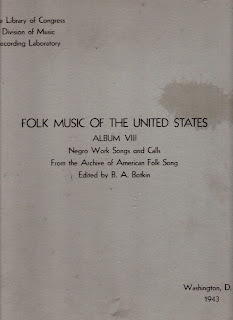01 Old Rattler.m4a
 |
| Folk Music of the United States, Album VIII Negro Work Songs and Calls, Edited by B.A. Botkin The Library of Congress, Division of Music, 78 rpm discs Washington, D.C., 1943 |
Rarely do I look for 78 rpm records when I browse through thrift store bins. And when I do I hardly ever get rewarded with something I'd want, it's even rarer when it is in OK condition. My collection of 78s is modest at best, I have about 40 of them but only half of these are valuable to me... and only two that I'm proud of having. The album Folk Music of the United States, Album VIII is one of these, even though the album is not complete, it is however in mint condition, and it includes the original booklet. There is a stain on the album cover that I first considered an eyesore but after I saw that it vaguely resembled the shape of the United States I considered it a bonus. If I were to sell the record on ebay (which I won't) I would advertise it as a 78 rpm record in mint condition with an original US stain on it. (The shape of Florida is cut off on the image above, it really is much more US than the photo suggests. I still don't have a scanner big enough to scan a full size record, the LoC album is oversized, it measures 14" x 12.5"). The song I picked to share with you is Old Rattler, sung by Moses (Clear Rock) Platt and James (Iron Head) Baker. It was recorded at the Central State Farm, Sugarland, Texas by John and Alan Lomax in 1934.
I found this album about two years ago at the Ohio Thrift Store next to the DeVry University on Alum Creek Drive in Columbus, Ohio.



